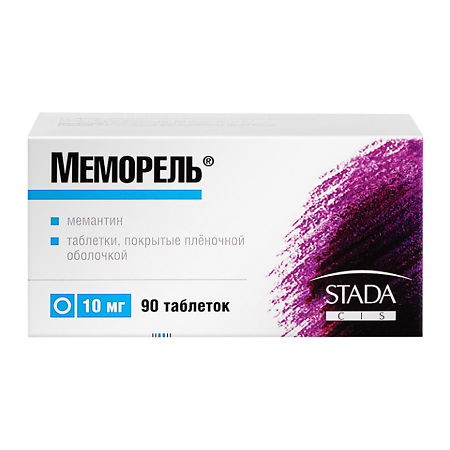No products in the cart.
Memorel, 10 mg tablets, 90 pcs.
€1.00
Out of stock
(E-mail when Stock is available)
Description
It has nootropic, cerebrovasodilatory, antihypoxic and psychostimulatory effects.
Adamantan derivative, similar to amantadine in chemical structure and pharmacological properties.
Blocks glutamate N-methyl-D-aspartate (NMDA)-receptors (including in the substantia nigra), thus reducing the excessive stimulatory effect of cortical glutamate neurons on the neostriatum, which develops against the background of insufficient dopamine release.
By reducing the supply of ionized calcium to neurons, it reduces the possibility of neuronal destruction. It has a greater effect on stiffness (rigidity and bradykinesia).
In addition to action on the central nervous system memantine affects efferent innervation.
Improves impaired memory, concentration, reduces fatigue and symptoms of depression, increases daily activity.
Pharmacokinetics
After oral administration is quickly and completely absorbed from the gastrointestinal tract. The maximum concentration is reached after 3-8 hours.
Food has no effect on absorption of the drug. A daily dose of 20 mg leads to an equilibrium plasma concentration of 70 to 150 ng/ml.
The volume of distribution is about 10 l/kg. The binding to plasma proteins is 45%.
Memantine cumulation is not observed in normal renal function. 80% of circulating memantine in blood is represented by unchanged substance.
Metabolism occurs without the participation of cytochrome P450. The major metabolites are N-3,5-dimethylgludantane, an isomeric mixture of 4- and 6-hydroxymantine and 1-nitroso-3,5-dimethyladamantane.
None of the metabolites has antagonistic activity to NMDA receptors. It is excreted mainly by the kidneys.
Excretion is monophasic with half-life of 60-100 h, clearance is 170 ml/min/1.73 m2, partially secreted by renal tubules.
In alkaline urine the drug excretion slows down (on average by 80% at urine pH 8).
Indications
Indications
Medium to severe dementia in Alzheimer’s disease.
Active ingredient
Active ingredient
Composition
Composition
1 film-coated tablet contains:
The active ingredient:
Memantine hydrochloride – 10.00 mg
Associates:
Lactose monohydrate – 192.5 mg,
Microcrystalline siliconized cellulose (36.75 mg – microcrystalline cellulose, colloidal silicon dioxide – 0.75 mg) – 37.50 mg,
Talk – 2.50 mg,
Magnesium stearate – 2.50 mg.
Composition of the film coating:
Opadry OY-S-28959 white (hypromellose (hydroxypropyl methylcellulose) – 3.1250 mg,
Titanium dioxide – 1.5625 mg, triacetin – 0.3125 mg.
How to take, the dosage
How to take, the dosage
The drug is taken orally, regardless of meals.
In the first week, the daily dose is 5 mg (in the morning). During the second week, the daily dose is 10 mg (5 mg twice a day). During the third week, the daily dose is 15 mg/day (10 mg in the morning and 5 mg in the evening).
From week 4, the daily dose is 20 mg/day. The maximum daily dose is 20 mg/day.
Dose adjustment in elderly patients (over 65 years) is not required.
In moderate renal insufficiency (creatinine clearance 50-80 ml/min), no dose adjustment is usually required;
In creatinine clearance 30-49 ml/min, the daily dose does not exceed 10 mg initially, then after 7 days if well tolerated, the dose can be increased up to 20 mg.
In severe renal failure (creatinine clearance 5-29 ml/min) the daily dose should not exceed 10 mg.
In mild to moderate hepatic impairment (Child-Pugh class A and B), no dose adjustment is required.
Interaction
Interaction
In concomitant use may weaken the effect of barbiturates and neuroleptics.
The effects of baclofen and dantrolene may be altered by memantine, so doses may need to be adjusted.
When memantine is used concomitantly with levodopa drugs, dopamine agonists, anticholinergic agents the effects of the latter may be enhanced.
Because memantine and amantadine are NMDA receptor antagonists, concomitant use should be avoided due to the risk of developing toxic effects.
Combinations of memantine with ketamine, dextromethorphan and phenytoin are also potentially toxic.
The same renal cation system is used to transport amantadine, cimetidine, ranitidine, quinidine, procainamide, quinine and nicotine in the body, which may cause these drugs to interact with memantine, leading to increased plasma concentrations.
When used concomitantly, memantine may cause a decrease in the serum concentration of hydrochlorothiazide.
Concomitant use with warfarin and other indirect anticoagulants requires close monitoring of prothrombin time and international normalized ratio.
Special Instructions
Special Instructions
In alkaline urine reactions, more careful monitoring of patients is required because of delayed excretion of memantine.
Impact on driving and operating machinery
Caution should be exercised when driving a vehicle and performing work requiring increased concentration.
Synopsis
Synopsis
Features
Features
Contraindications
Contraindications
Side effects
Side effects
Overdose
Overdose
Symptoms:
Dizziness, tremor, agitation, drowsiness, clouded consciousness, agitation, stupor, seizures, aggressiveness, hallucinations, unsteady gait, vomiting, diarrhea.
Treatment:
Gastric lavage, administration of activated charcoal; symptomatic therapy. There is no specific antidote. Excretion of the drug can be accelerated by acidification of the urine.
Pregnancy use
Pregnancy use
The use of Memorel ® is contraindicated in pregnancy and lactation.
Memantine has the ability to slow down the development of the fetus.
Breastfeeding should be stopped during treatment with memantine.
Similarities
Similarities
Additional information
| Shelf life | 2 years. Do not use later than the date on the package. |
|---|---|
| Conditions of storage | In a dry, light-protected place at a temperature not exceeding 25 ° C. Keep out of reach of children. |
| Manufacturer | Bilim Iliaç Sanayi ve Ticaret, Turkey |
| Medication form | pills |
| Brand | Bilim Iliaç Sanayi ve Ticaret |
Related products
Buy Memorel, 10 mg tablets, 90 pcs. with delivery to USA, UK, Europe and over 120 other countries.













